
Sentō (銭湯) is a type of Japanese communal bathhouse where customers pay for entrance. Traditionally these bathhouses have been quite utilitarian, with a tall barrier separating the sexes within one large room, a minimum of lined-up faucets on both sides, and a single large bath for the already washed bathers to sit in among others. Since the second half of the 20th century, these communal bathhouses have been decreasing in numbers as more and more Japanese residences now have baths. Some Japanese find social importance in going to public baths, out of the theory that physical proximity/intimacy brings emotional intimacy, which is termed skinship in pseudo-English Japanese. Others go to a sentō because they live in a small housing facility without a private bath or to enjoy bathing in a spacious room and to relax in saunas or jet baths that often accompany new or renovated sentōs.

A hammam or Turkish bath is a type of steam bath or a place of public bathing associated with the Islamic world. It is a prominent feature in the culture of the Muslim world and was inherited from the model of the Roman thermae. Muslim bathhouses or hammams were historically found across the Middle East, North Africa, al-Andalus, Central Asia, the Indian subcontinent, and in Southeastern Europe under Ottoman rule. A variation on the Muslim bathhouse, the Victorian Turkish bath, became popular as a form of therapy, a method of cleansing, and a place for relaxation during the Victorian era, rapidly spreading through the British Empire, the United States of America, and Western Europe.

In ancient Rome, thermae and balneae were facilities for bathing. Thermae usually refers to the large imperial bath complexes, while balneae were smaller-scale facilities, public or private, that existed in great numbers throughout Rome.
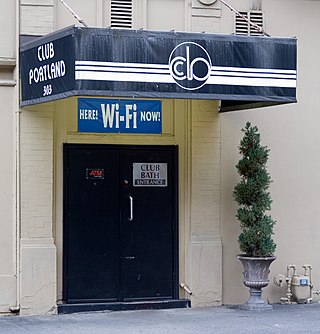
A gay bathhouse, also known as a gay sauna or a gay steambath, is a public bath targeted towards gay and bisexual men. In gay slang, a bathhouse may be called just "the baths", "the sauna", or "the tubs". Historically they have been used for sexual activity.

Bathing is the act of washing the body, usually with water, or the immersion of the body in water. It may be practiced for personal hygiene, religious ritual or therapeutic purposes. By analogy, especially as a recreational activity, the term is also applied to sun bathing and sea bathing.

Hot Springs National Park is an American national park in central Garland County, Arkansas, adjacent to the city of Hot Springs, the county seat. Hot Springs Reservation was initially created by an act of the United States Congress on April 20, 1832, to be preserved for future recreation. Established before the concept of a national park existed, it was the first time that land had been set aside by the federal government to preserve its use as an area for recreation. The hot spring water has been popularly believed for centuries to possess medicinal properties, and was a subject of legend among several Native American tribes. Following federal protection in 1832, the city developed into a successful spa town.
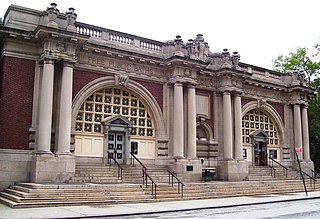
Public baths originated when most people in population centers did not have access to private bathing facilities. Though termed "public", they have often been restricted according to gender, religious affiliation, personal membership, and other criteria. In addition to their hygienic function, public baths have also been social meeting places. They have included saunas, massages, and other relaxation therapies, as are found in contemporary day spas. As the percentage of dwellings containing private bathrooms has increased in some societies, the need for public baths has diminished, and they are now almost exclusively used recreationally.

A spa is a location where mineral-rich spring water is used to give medicinal baths. Spa towns or spa resorts typically offer various health treatments, which are also known as balneotherapy. The belief in the curative powers of mineral waters goes back to prehistoric times. Such practices have been popular worldwide, but are especially widespread in Europe and Japan. Day spas and medspas are also quite popular, and offer various personal care treatments.

A banya is originally a Russian steam bath with a wood stove. It is considered an important part of Russian culture. The bath takes place in a small room or building designed for dry or wet heat sessions. The steam and high heat make the bathers perspire. Genders were traditionally segregated in the banya, with separate rooms for the sexes.
The Continental Baths was a gay bathhouse in the basement of The Ansonia Hotel in New York City, which was operated from 1968-1976 by Steve Ostrow. It was advertised as reminiscent of "the glory of ancient Rome".
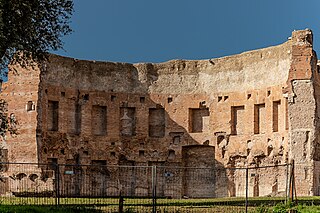
Bathing played a major part in ancient Roman culture and society. It was one of the most common daily activities and was practiced across a wide variety of social classes. Though many contemporary cultures see bathing as a very private activity conducted in the home, bathing in Rome was a communal activity. While the extremely wealthy could afford bathing facilities in their homes, private baths were very uncommon, and most people bathed in the communal baths (thermae). In some ways, these resembled modern-day destination spas as there were facilities for a variety of activities from exercising to sunbathing to swimming and massage.
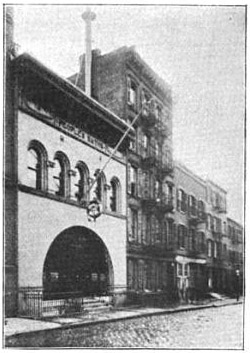
Centre Market Place is a one block long street in Lower Manhattan, New York City, bordering Mulberry Street to the east, Grand Street to the south, Broome Street to the north, and Centre Street to the west. Centre Market Place was originally an extension of Orange Street, before being formally renamed Centre Market Place in April 1837, after Centre Market, which was west of the street. At one time, the street was at the top of a high hill. Currently, local residents consider Centre Market Place to be part of the NoLIta neighborhood. At the southern end of the street, on the corner of Grand Street, is Onieal's restaurant, which features a cavernous wine cellar that once served as a speakeasy during Prohibition. Gentlemen of means would walk through the front of the Police Building, perhaps make a contribution to the "widows and orphan fund" and then walk through the cellar corridor connecting the two buildings.

The Everard Baths or Everard Spa Turkish Bathhouse was a gay bathhouse at 28 West 28th Street in New York City that operated from 1888 to 1986. The venue occupied an adaptively reused church building and was the site of a deadly fire.
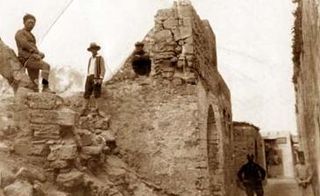
Hamam al-Sammara is the only active Turkish bath remaining in Gaza, located in the Zeitoun Quarter of the Old City. It is situated 3 meters (9.8 ft) below street level. It is currently owned by Salim Abdullah al-Wazeer.

The Asser Levy Recreation Center is a recreational facility in Kips Bay, Manhattan, New York City, composed of the Asser Levy Public Baths and Asser Levy Playground. It is bounded by East 23rd Street to the south, East 25th Street to the north, and FDR Drive to the east. Along with the former Asser Levy Place to the west, it was named after Asser Levy, one of New York City's first Jewish citizens and a strong and influential advocate for civil liberties.

Simon Baruch was a physician, scholar, and the foremost advocate of the urban public bathhouse to benefit public health in the United States.
Finnila's Finnish Baths—a.k.a. Finnila's—was a Finnish bathhouse and a health club in San Francisco, California. It served the general public from circa 1910 to September, 2000. Finnila's was located in the Castro District of San Francisco for its first 75 years.

Spanien Public Baths, colloquially known simply as Spanien, is a public bath house and a listed building in Aarhus, Denmark. The bath house was completed in 1931 and was listed on the Danish national registry of protected buildings and places by the Danish Heritage Agency on 15 February 1989 as a fine example of the Nordic funkis style. The building was thoroughly renovated in 2010–12.

Victorian Turkish bath or simply Turkish bath is a type of public bathhouse which was derived from the hammam (bathhouse) of the Islamic world and those Roman baths which used hot dry air. It became popular as a therapy, a method of cleansing, and a place for relaxation during the Victorian era, rapidly spreading through the British Empire, the United States of America, and Western Europe.

The Bañuelo or El Bañuelo, also known as the Baño del Nogal or Hammam al-Yawza, is a preserved historic hammam in Granada, Spain. It is located in the Albaicin quarter of the city, on the banks of the Darro River. It was used as a bathhouse up until the 16th century at least, before becoming defunct and being converted to other uses. In the 20th century it underwent numerous restorations by Spanish experts and is now open as a tourist attraction.

















